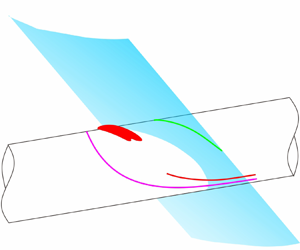No CrossRef data available.
Published online by Cambridge University Press: 06 February 2025

The interaction between planar incident shocks and cylindrical boundary layers is prevalent in missiles equipped with inverted inlets, which typically leads to substantial three-dimensional flow separation and the formation of vortical flow. This study utilizes wind-tunnel experiments and theoretical analysis to elucidate the shock structure, surface topology and pressure distributions induced by a planar shock with finite width impinging on a cylinder wall at Mach 2.0. In the central region, a refraction phenomenon occurs as the transmitted shock bends within the boundary layer, generating a series of compression waves that coalesce into a shock, forming a ‘shock triangle’ structure. As the incident shock propagates backward along both sides, it gradually evolves into a Mach stem, where the transmitted shock refracts the expansion wave. The incident shock interacts with the boundary layer, resulting in the formation of a highly swept separation region that yields a pair of counter-rotating horseshoe-like vortices above the separation lines. These vortices facilitate the accumulation of low-energy fluid on both sides. Although the interaction of the symmetry plane aligns with free-interaction-theory, the separation shock angle away from the centre significantly deviates from the predicted value owing to the accumulation of low-energy fluids. The primary separation line and pressure distribution jointly exhibit an elliptical similarity on the cylindrical surface. Furthermore, the potential unsteady behaviour is assessed, and the Strouhal number of the low-frequency oscillation is found to be 0.0094, which is insufficient to trigger significant alterations in the flow field structure.